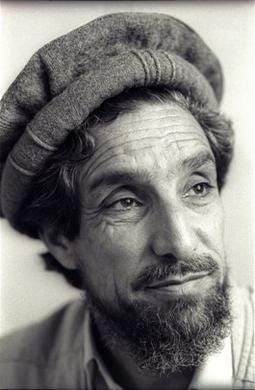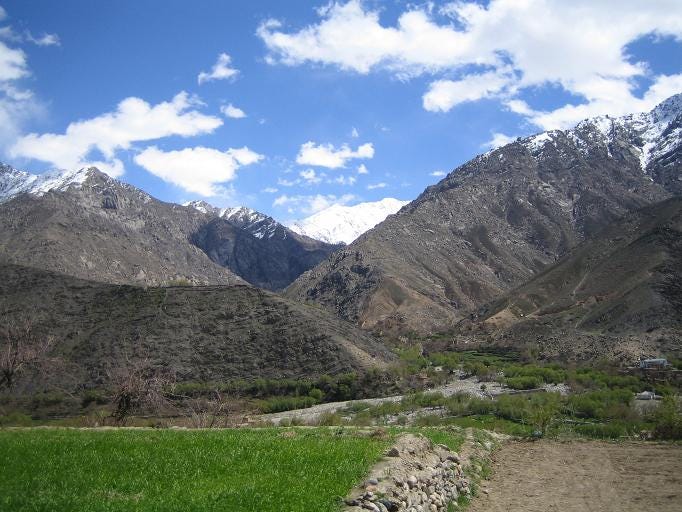The Panjshir Protocol
The Taliban offensive in Panjshir appeared to be going swimmingly with Pakistani Special Forces doing the bulk of the fighting. Then unidentified aircraft flew in from the north.
The covert operation described in this post didn’t happen. It was just a series of coincidences. Unbelievable coincidences.
But before we jump into this operation-that-definitely-certainly-absolutely-did-not-happen, let me begin with some context.
The CIA-GID gravy train in Afghanistan
The Soviet Union faced an Islamic insurgency in Afghanistan between Christmas Eve in 1979 and 15 February 1989. The belligerents arrayed against it included seven Sunni Islamic factions collectively called the Peshawar Seven, and eight Shia Islamic factions known as the Tehran Eight.
The Peshawar Seven were backed by Inter-Services Intelligence (ISI) of Pakistan, with billions of dollars worth of resources primarily from the United States and Saudi Arabia. As early as July 1980, Prince Turki bin Faisal Al Saud — the director general of Saudi Arabia’s General Intelligence Directorate — reached an agreement with the CIA to match US congressional funding for the Peshawar Seven. The money and weapons were, of course, handed over to ISI in Islamabad. Distribution among the Peshawar Seven was left to ISI’s discretion.
This arrangement suited GID just fine. As Turki once told a CIA colleague:
We [GID] don’t do operations. We don’t know how. All we know how to do is write cheques.
Ahmad Shah Massoud
Those factions of the Peshawar Seven who were the favourites of ISI found themselves receiving a lion’s share of the resources. Ahmad Shah Massoud was not so lucky. Officers of the ISI’s Afghan bureau saw Massoud as an independent-minded commander, someone much harder to control than his peers. The Afghan bureau dreamt of exerting control over Afghanistan, and Massoud wouldn’t be easy for them to control, so it wasn’t surprising that his faction received scraps after all the other factions had eaten their fill. Besides, Massoud was a Tajik, and the Pashtun-dominated bureau preferred fellow Pashtuns like the odious Gulbuddin Hekmatyar.
That didn’t stop him from raising hell in the Panjshir Valley, just 150 kilometres north of Kabul. The Soviets launched Operation Panjshir to gain control of that valley. When that failed, they launched Operation Panjshir II, and III. And IV. And V. And VI. And VII, and VIII, and IX. Taken all together, the offensives spanned three General Secretaries of the Communist Party of the Soviet Union.
Collectively known as the Panjshir Offensives, these failed to dislodge Massoud’s forces. Soviet and Afghan troops present in the lower Panjshir valley were evacuated in June 1988.
After the ISI-backed Taliban took Kabul on 26 September 1996, Massoud and his allies mounted a fierce resistance of the northern part of Afghanistan. A week later Bharath Raj Muthu Kumar, the Indian Ambassador to Tajikistan received a telephone call from Amrullah Saleh, one of Massoud’s lieutenants. The commander wished to meet the Ambassador.
The meeting took place at Massoud’s house in Dushanbe, the capital of Tajikistan, with Saleh interpreting for Massoud.
For the next four years, the Indian government sent aid — uniforms, ordnance, mortars, small armaments, refurbished Kalashnikovs seized in Kashmir, combat and winter clothes, packaged food, medicines — through India’s air bases in Tajikistan at Farkhor.
The supplies arrived regularly at Dushanbe, and the Tajik customs ensured the smooth transfer to Farkhor, at the border between Tajikistan and northern Afghanistan, where Massoud maintained around 10 helicopters for his war efforts. New Delhi also helped maintain the helicopters with spares and service. Between 1996 and 1999 India gifted two Mi-8 helicopters.
— V. Sudharshan, The Hindu
In 1999, Massoud selected Saleh and a few other aides to attend a CIA training course in the US. While the course struck a balance between intelligence and paramilitary aspects, Saleh found himself drawn to the former. This would change the trajectory of his life.
While Massoud’s allies like Abdul Rashid Dostum fell to Taliban assaults and went into exile, Massoud was able to defend the Panjshir Valley right up until his assassination by Al Qaeda on 9 September 2001.

Taliban offensives in Panjshir
Fast forward twenty years, and the valley is once again experiencing fierce fighting between the Taliban and the National Resistance Front (NRF) led by Ahmad Shah Massoud’s son (also named Ahmad).
He is aided and advised by Amrullah Saleh, who spent the intervening years first building & heading Afghanistan’s spy agency (the NDS) and then as the nation’s First Vice President. During his time in the NDS, Saleh was a thorn in the ISI’s flesh, running agents and gathering intelligence on Pakistan’s support for the Taliban.
He had spent countless hours warning officials in the US establishment about Pakistan’s support for Taliban, the Haqqani network, and Al-Qaida, and had even forecast, among other things, an increase in violence in Kabul.
The Pakistani government often leaned on Hamid Karzai to remove Saleh from the NDS. Apart from the manner in which he had grown the NDS into a formidable intelligence machine with a range of sources inside Pakistan, what got Rawalpindi’s goat was the fact that Saleh collaborated extensively with Indian intelligence.
The conflict began with a gung-ho Taliban rushing troops into Panjshir. The NRF was able to inflict severe casualties on them, unaccustomed as the Taliban were to the mountainous terrain of Panjshir.

Pakistani meddling
Multiple sources, Afghan and otherwise, joined Ahmad Massoud in claiming that the Pakistan Army was helping the Taliban establish their government in Kabul and attack NRF positions in Panjshir. Tehran was particularly incensed.


Lt Gen Faiz Hameed, Director General of the ISI, rushed to Kabul in order to mediate between rival factions within the Taliban.
“According to Afghan sources, Hameed rushed to Kabul after a clash between Baradar and Haqqani-supported groups in which Baradar sustained injuries,” Ex-Pentagon official Michael Rubin has written in an article.
Around the same time, multiple sources claimed that after the Taliban’s initial losses, the Pakistan Army had put boots on the ground in the effort against the NRF in Panjshir.

The Pakistan Army has used helicopter gunships against the NRF, with Lt Gen Hameed coordinating operations from Kabul.

The scale of the Pakistani effort was significant: 27 helicopters and 390 soldiers of Pakistan Army’s Special Services Group (SSG) were doing the heavy lifting in the fight against the NRF in Panjshir.


Rapid progress
With Pakistan’s Special Forces leading the fighting against the NRF, the Taliban began making significant gains, capturing multiple towns inside the valley proper. They even claimed to have captured Panjshir in its entirety, a claim that was rebuffed by the NRF. Following in Ahmad Shah Massoud’s footsteps, the NRF appears to be avoiding open battle and is retreating into the numerous side valleys of Panjshir.
Given Saleh’s history with the ISI, it is no surprise that Pakistani Special Forces are gunning for his head. But they appear to have made little headway, and might have even been lured into an ambush.

Despite claims and counter-claims, the tide of battle appeared to have turned conclusively in favour of the Taliban+ forces. They captured and desecrated Ahmad Shah Massoud’s tomb inside Panjshir on his 20th death anniversary.
Unidentified aircraft
Then something unexpected happened.
Unidentified aircraft flew in from the north and carried out airstrikes on Taliban positions in Panjshir.


Speculation was rife that the aircraft belonged to the erstwhile Afghan Army that had fled to Tajikistan. The Afghans would have had to surmount a significant logistical challenge to secure fuel, weapons, and crew in a third country for the assault. They would also have had to coordinate with the NRF to fly the mission, but all that isn’t impossible.
But then reports began trickling in that a number of Pakistani soldiers had been slaughtered in the air assault. The aircraft appeared to have targeted Pakistani positions.

This was happenstance.
On a completely unrelated note, Ayni in Tajikistan, near the capital Dushanbe, hosts an air base that is jointly operated by the Indian Air Force and the Tajik Air Force. India is rumoured to have stationed a sub-squadron strength detachment of Su-30MKI aircraft there since 2014.
Ayni is roughly 360 km from Panjshir, and the Sukhois have stand-off weapons that can be fired from more than 100 km away.
But if Sukhois were to target Pakistani troops using stand-off munitions, they would require precise intelligence about Pakistani troop positions from within the Panjshir valley. Intelligence of the sort that the former head of the NDS — who happens to have collaborated with India’s intelligence agencies — might be able to provide, for example.
This was a coincidence, of course.
Right around the time when the airstrikes took place on Pakistani troops, resulting in heavy casualties among their elite SSG, Lt Gen Hameed was summoned back to Rawalpindi in Pakistan. He was marched into the Adjutant General Lt Gen Muhammad Amir’s office and disciplined for his unauthorised visit to Kabul, a humiliating ordeal for a three-star general.
The Adjutant General (AG), Lt General Muhammad Amir, had issued a letter to the DG ISI and asked him to appear before the AG to explain his violation of military disciple. When Lt General Faiz Hameed arrived to attend the hearing at the GHQ (September 10), he was thoroughly humiliated. He was marched into the AG’s office, which means he was cautioned at the door and the ISI flag was stripped of his motor vehicle before it was allowed to enter the GHQ premises.
Lt Gen Hameed accepted the charges and sought pardon from Gen Bajwa.
This is also a coincidence.
In the coming days, people around the world who despise the Pakistani state for its unabashed support of terrorist groups will hope for many more such happy coincidences.
If you enjoyed reading this story, please share it with your friends, and subscribe to receive new stories in your inbox.
You might also enjoy reading my spy novels: Let Bhutto Eat Grass & Let Bhutto Eat Grass: Part 2 deal with nuclear weapons espionage in 1970s India, Pakistan, and Europe. Part 3 is on its way.












Very well written
Beautiful write up. Keep updating